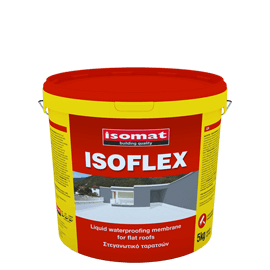ISOFLEX is an elastomeric, water-based, liquid waterproofing membrane for flat roofs. Has excellent bonding to various substrates, such as concrete, wood, metal and any type of waterproofing membranes and is applivable even to irregular substrates. After curing, it forms a continuous, elastic, waterproof and vapor-permeable membrane, without seams or joints, offering:
- High elasticity
- High resistance to weather conditions and aging.
- High whiteness and solar reflectance
- Improvement of building energy efficiency by decreasing the roof temperature.
The white is certified as cool paint. Certified according to EN 1504-2 and classified as a coating for roof details, such as corners, edges and joints between different adjacent materials, as well as for isolated cracks. Furthermore, thanks to its high solar reflectance, it can be used as cool roof paint.
Substrate preparation
The substrate must be dry, clean, free of grease, loose particles, dust, etc. Any existing cavities in concrete should be filled in advance. The substrate can be primed with the special primer ISO-PRIMER with a consumption of approx. 200 g/m2.
Application
a) Full-surface waterproofing
ISOFLEX is applied by brush or roller in two layers, after the primer has dried. The second layer should be applied crosswise after the first one has dried. In areas with severe cracks, it is recommended to reinforce ISOFLEX with a 10 cm wide strip of fiberglass mesh (65 g/m2) or polyester fleece (30 g/m2) along the cracks. In that case, after the primer has dried, the first layer of ISOFLEX is applied along the cracks and while still fresh, the 10 cm wide strip of fiberglass mesh or polyester fleece is embedded lengthwise. Subsequently, two extra layers of ISOFLEX are applied over the entire surface. Consumption: approx. 1.5 kg/m2, depending on the substrate. In case there are dense, multiple cracks all over the surface, it is strongly recommended to fully reinforce ISOFLEX membrane with 100 cm wide strips of fiberglass mesh (65 g/m2) or polyester fleece (30 g/m2). These placed strips must overlap by 5-10 cm. After the primer has dried, a first layer of ISOFLEX is applied to a width of 100 cm (as wide as the uncoming reinforcement), and while still fresh, a strip of fiberglass mesh or polyester fleece is embedded. The same application process is followed until the remaining surface is covered. Subsequently, two extra layers of ISOFLEX are applied over the entire surface.
b) Local waterproofing of cracks
In the case, the primer is applied on the substrate only along the cracks to a width of 10-12 cm. After the primer has dried, the first ISOFLEX layer is applied and while still fresh, a 10 cm wide strip of fiberglass mesh (65 g/m2) or polyeste fleece (30 g/m2) is embedded lengthwise.




